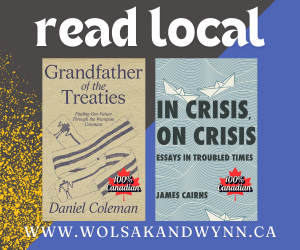Sharing the LRT goldmine
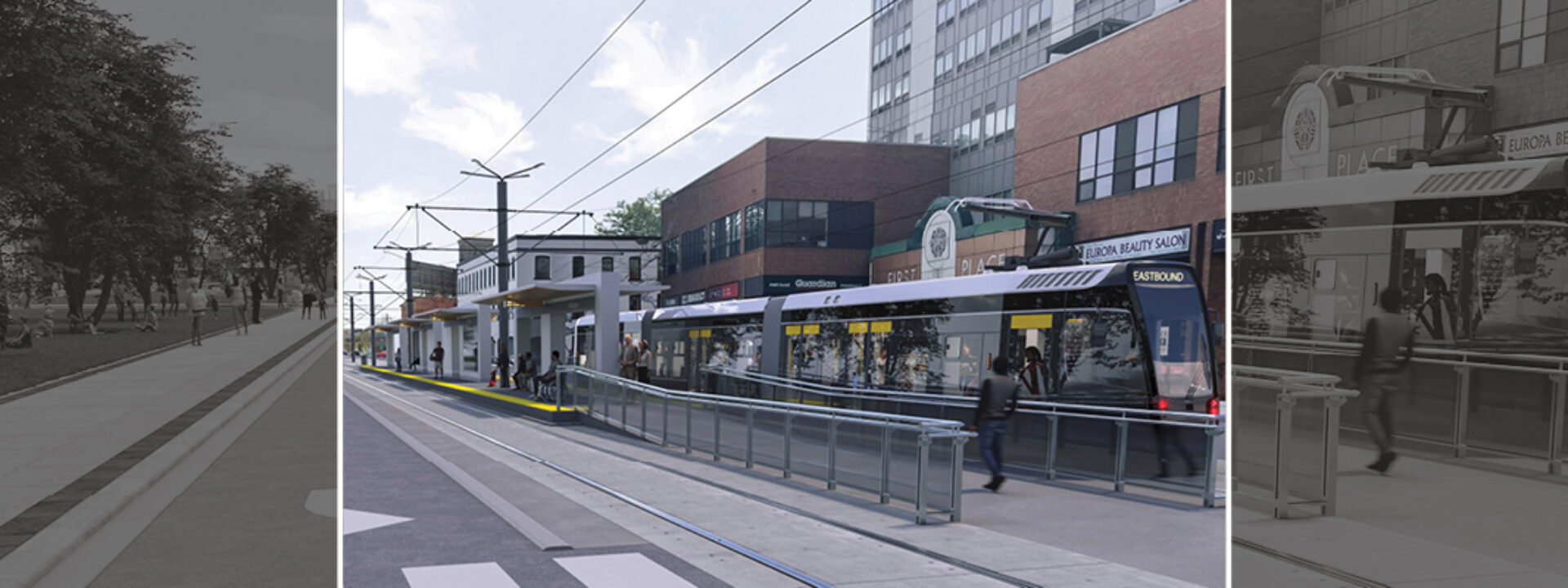
Pilot project aims to provide an alternative future for Hamilton’s transit corridor, one that includes affordable housing alongside upscale high-rises.
A land speculation bonanza is underway along Hamilton’s King and Main streets triggered chiefly by the largest infrastructure project in the city’s history, the $3.4-billion light rail transit line.
Like every other major city in Canada, high levels of immigration and demand for urban housing are driving up property values. But the city’s ambitious mass transit project cutting through a long stretch of aging, affordable housing has contributed to a sharp rise in rents and land values downtown.
This grand plan has come at a high price for people who live near the transit line. Historic single-family dwellings, row houses and walkup apartments that were once a refuge for the working poor and people on social assistance are disappearing, giving way to upscale high-rises.
But what if it doesn’t have to be this way? What if there is a way for Hamilton to reap the benefits of the LRT while preserving its downtown neighbourhoods? This is the aim of a recent progressive pilot project in Hamilton focusing on a new urban planning idea called equitable transit-oriented housing.
Rather than standing back as neighbourhoods are taken over by high-rise rentals and condos, the new thinking is to create a mix of large and small buildings along mass transit routes, better serving low-income people in need of affordably priced housing and public transit.
“When the market hears that there’s going to be development, we start to see speculation,” says Andrea Nemtin, CEO of Social Innovation Canada (SI Canada), a national think tank that coordinated the project. “Communities get displaced, and they can’t come back, because when it’s all done, the land values are too high.”
Nemtin’s project – called the Hamilton Transit-Oriented Affordable Housing Lab – drew participants from nearly 30 municipal, provincial and national housing agencies, non-profit housing providers, community leaders and housing support groups. The aim of the project, which completed two years of work in late 2024, was to identify and find money for new affordable housing sites along Hamilton’s transit corridor. Participants also wanted to figure out how to replicate the process in other cities.
16,000 affordable apartments gone
Back in 2015, when then-Ontario premier Kathleen Wynne first announced the LRT project, development land in downtown Hamilton was going for $2 million an acre, says community organizer Karl Andrus, a vocal and active participant in the SI Canada project. Ten years later, it has exploded to $15 million to $20 million an acre.
Land speculation has generated tragic results. Census figures compiled by the Hamilton Community Foundation show that the city lost about 16,000 units of “affordable housing” between 2011 and 2021. These are apartments that rent for below $750 a month, the level considered affordable for a family earning $30,000 a year.
“When you lose that many units, people have a couple of different choices,” says Andrus, community benefits manager for the Hamilton Community Benefits Network. “They can either get a bunch of roommates and cram into a smaller place, or they can end up unhoused.”
People on Ontario Works (OW) and the Ontario Disability Support Program (ODSP) are particularly hard hit, he says. “There’s a direct correlation between those lost units that people can afford on OW or ODSP and the numbers of people ending up in encampments.”
Faced with such an enormous challenge, the task now is to build as many non-market housing units as possible, keeping the units permanently affordable and out of the land speculation market, says Nemtin. “If you can have planning that actually identifies the land that’s going to be increasing in value, and the non-profit and the City housing providers can get in front of that, then they can benefit from the land value uplift.”
So, was the SI Canada project successful in identifying such properties? Yes, and no.
With land values as high as $20 million an acre, it’s tough going for community housing providers to obtain land in the transit corridor that’s cheap enough for affordable housing. But one of the organizations participating in the SI Canada process is optimistic it can crack that nut.

Hamilton East Kiwanis Non-Profit Homes is a charity that has been operating for over 40 years, offering 1,100 affordable housing units in multi-storey apartment buildings and individual homes.
Like many non-profit housing providers, Kiwanis obtained low-cost houses from federal mortgage insurer Canada Mortgage and Housing Corp. (CMHC) in the 1980s after high interest rates forced thousands of Canadians to default on their mortgages. CMHC provided advantageous financing to providers like Kiwanis to take over the abandoned mortgages and use the properties for affordable housing.
Over the years, Kiwanis sold some of these properties – including a number close to the LRT line – to fund construction of new apartment buildings. But after rents and house prices near the LRT skyrocketed, it dawned on executive director Brian Sibley and his board that Kiwanis itself had become part of the problem.
“If we had continued on that road,” says Sibley, “we would have been adding to gentrification, not reducing gentrification.”
After participating in an SI Canada working group, Kiwanis changed its strategy.
200 fourplex units planned
Now, Kiwanis plans to retain single-family properties close to the LRT and slowly redevelop them into fourplexes, using a new Hamilton city council policy permitting fourplex conversions on single family lots. Kiwanis is currently working on a pilot to convert three of these dwellings into 12 affordable units. If this goes well, Sibley is hopeful that Kiwanis can build about 200 new units by 2028.
The units will lightly increase the density of these neighbourhoods, preserving their character and making it easy for residents to get around by transit and walking, he says. “What we’re talking about is a very gentle density that really preserves walkability.”
One of the great things about this idea is that it could be done by virtually anyone who owns a single family-home, says Sibley. “There’s a huge opportunity there. It’s not just limited to the affordable housing sector.”

Other community housing providers participating in the SI Canada working groups were unable to go ahead with their projects because they couldn’t secure startup funding. Without this initial funding, they weren’t able to develop proposals for federal or provincial grants, or CMHC, bank or credit union financing.
YWCA Hamilton identified a vacant commercial property at 499 King St. E. as a potential site for 10 affordable units for women and gender-diverse people and their families. It was a good candidate for the SI Canada process, situated only 100 metres from a planned transit station. But it was foiled by lack of startup funding.
Nemtin, who has worked for 25 years in the philanthropic and impact investing sectors, says the lack of financing and funding for project startups, property acquisition and building construction is a huge barrier to the development of affordable housing. To meet this need, SI Canada secured commitments from investors to launch a revolving loan fund for transit-oriented affordable housing in Hamilton.
$15-million fund in the works
The group has issued a request for proposals (RFP) for a fund manager. The $15-million fund will be structured on a “blended finance” model, which is a mix of grants, and below-market and market-rate investments.
One of the most important features of the fund is that it will coordinate private financing from charities and investors with grants from the City of Hamilton’s Housing Secretariat, established in 2023. Earlier this year, the secretariat announced a first round of startup funding of $8.2 million for 11 affordable housing projects.
Andrus says the SI Canada fund will help to address challenges of startup and construction financing. But there’s another problem – lack of low-cost land – that is also a big barrier to affordable housing.
He’s hopeful that the post-pandemic real estate slump will prompt some developers to offload their properties cheaply to non-profit housing providers. The city also has a large inventory of empty parking lots, churches and non-profit organizations that may also be able to supply low-cost land.
But he says Metrolinx – the provincial agency building the LRT – must be pressured to free up land from its 12- to 15-acre bank of properties that it won’t need for completion of the transit line.
If surplus Metrolinx land in Hamilton is turned over to the City or community housing groups at the same cost Metrolinx paid for it, Andrus estimates it could help to create 2,000 to 3,000 affordable housing units. “That presents a unique opportunity for the public sector and for non-profits to build housing if only they’re afforded the chance to buy that land at cost.”
But Metrolinx operates under a rule called the Ontario realty directive, a government policy requiring provincial agencies to dispose of surplus land at market value, which is the price a developer is willing to pay.
When asked for this article whether it is considering affordable housing for its surplus LRT lands, Metrolinx issued a curt two-line reply: “As a provincial agency, all transactions involving Metrolinx are subject to the Ontario realty directive. Details regarding surplus lands will be determined as the project progresses.”

Still, Andrus is hopeful the province and Metrolinx may be open to pressure after a community uproar in 2021 forced the province to provide two acres of Metrolinx land for a community centre adjacent to an LRT facility in Toronto. What Hamilton needs to avoid, he says, is a situation like the one in Mississauga in 2022 when Metrolinx sold a parking lot adjacent to the Port Credit GO station for an astounding $64.5 million. It was a massive windfall for Metrolinx but did nothing for affordable housing.
Both Nemtin and Andrus believe that Hamilton can rally community support for affordable housing in the transit corridor. Nemtin says the city is fortunate to have strong local networks like the City’s Housing Secretariat, the Hamilton Community Foundation, the Hamilton is Home non-profit housing coalition and the Hamilton Community Benefits Network. This is one of the reasons SI Canada chose Hamilton to pilot the idea.
Andrus agrees that the close connections between community leaders make Hamilton a good place to fight for the idea of equitable transit-oriented housing.
“One of the strengths of Hamilton is that although we’re a large city, it’s more like a small town.”
Trainwreck documentary tells story of LRT evictions
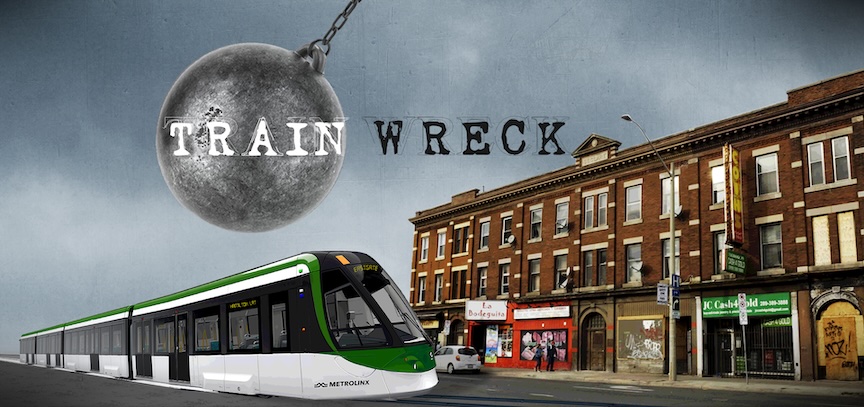
The plight of Hamilton residents evicted from their downtown homes by Metrolinx, the provincial transit agency, is the subject of Trainwreck, a moving and compassionate documentary film.
“There are dozens of tenants who have lost their homes and were pushed out of very affordable apartments into a rental market that had skyrocketing rents and very low vacancy,” says Emily Power, the movie’s producer. “These people deserve some form of justice for the hardship they’ve been through.”
One of the most moving stories in the film is that of 69-year-old Sharon Miller, who for 20 years had lived with her ailing husband in a first-floor apartment of a two-storey building on King, east of Gage. It was one of about 80 full properties and 71 partial lots that Metrolinx has acquired or plans to acquire for the LRT line.
Miller, suffering from post-traumatic stress disorder after witnessing a friend fall to their death from an apartment balcony years earlier, refused to accept accommodation offers from Metrolinx that would have placed her and her husband on upper floor units in high rises.
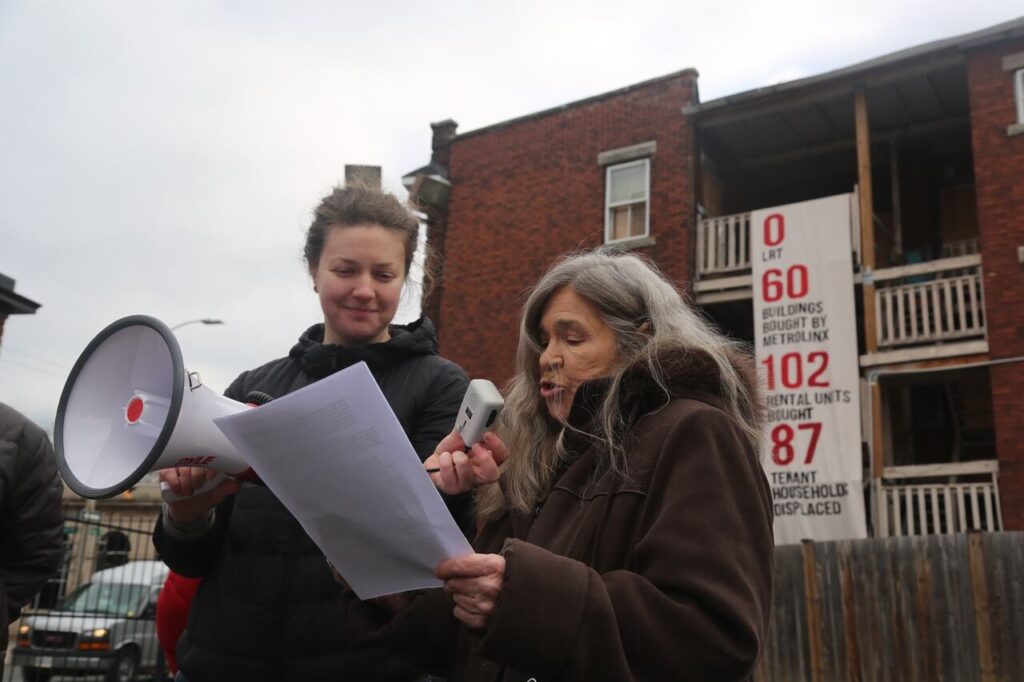
After fighting to stay in her building for nearly five years, she and her husband finally moved into the first floor of a new social housing building. Tragically, both passed away only months after their move in 2023.
Power got to know Miller and other displaced tenants while living in the neighbourhood in 2017. Soon after, she decided to make the documentary with fellow filmmakers Alex Balch and Taras Hemon. “We made friends with some of the tenants and stayed connected with them through the years. And we felt that these stories weren’t getting the attention they deserved.”
The film played to packed audiences last year at the Hamilton Film Festival and the Playhouse Theatre as well as the Nia Centre for the Arts in Toronto.
There is no narrator in the film and it does not argue for a particular solution to the plight of those who lost their homes. Instead, it takes great lengths to let the people displaced by the transit line tell their own stories in their own words.
To ease the displacement, Metrolinx agreed to try to find similar accommodation suitable to each tenant. Temporary rent subsidies to make the difference were provided on a case-by-case basis. According to Metrolinx, 100 tenants had been relocated by last November and another 30 were in the process of finding a new place to live. The Hamilton Community Benefits Network estimates the total number of people displaced is higher – between 200 and 300 – since many tenants moved out after getting eviction notices or cash payments from their landlords.
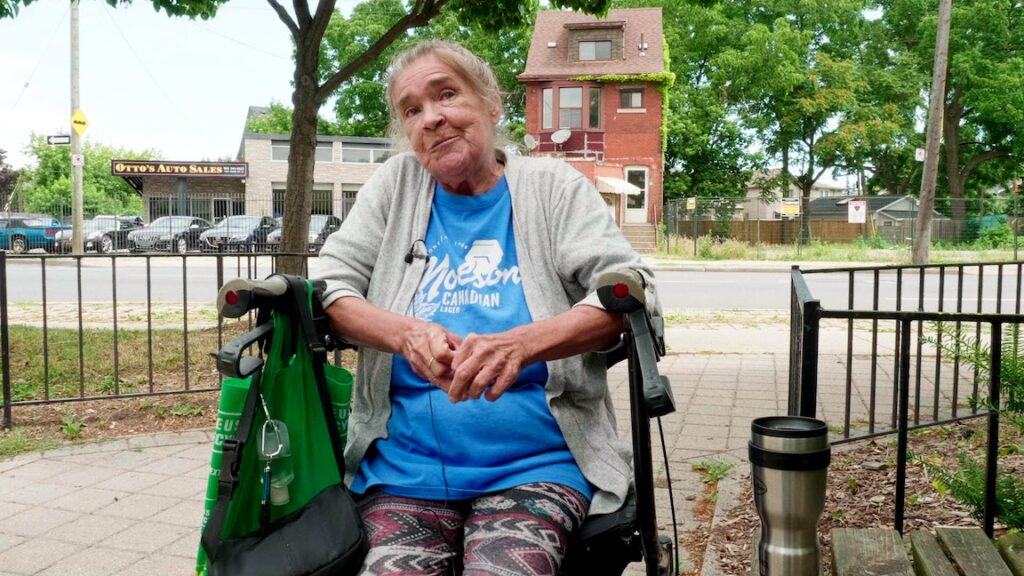
Some viewers of the film have come away thinking the documentary is anti-LRT, suggesting the transit project should be cancelled. But Power emphasizes that Metrolinx and the province have a responsibility to provide affordable housing as well as public transit. Otherwise, the LRT will simply benefit wealthy developers and high-income transit users.
As the late Sharon Miller says in the film: “Landlords are throwing people out, putting rents up, and it’s for the gentrification of downtown Hamilton. It’ll be for the people who come in here with money, not for the people that work and live here.”
Eugene Ellmen writes on sustainable business and finance. He lives in downtown Hamilton.












